Construction Risk Management: A Comprehensive Guide
-
Sapna
- May 17, 2024
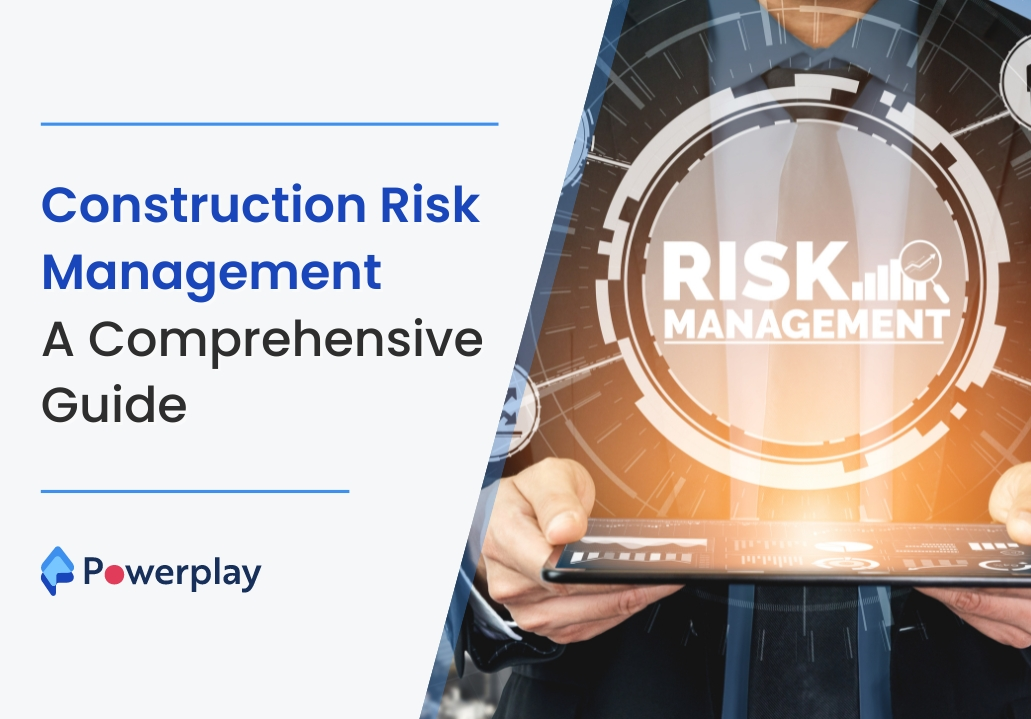
Managing risks is not just a necessity but a vital factor in establishing the success of any project. With the construction sector experiencing a high incidence of accidents and significant financial losses due to cost overruns, the need for comprehensive risk management strategies has never been more apparent.

In this blog, explore essential practices for identifying, assessing, and mitigating risks to ensure projects run smoothly, on time, and within budget. Whether you’re a seasoned professional or new to the field, discover the strategies that can safeguard your projects against unexpected challenges and enhance your operational efficiency.
Table of Contents
What Is Construction Risk Management?
Construction risk management is analysing, identifying, and responding to risks associated with construction projects to minimise their impact on the project’s success. This involves systematically using management policies, procedures, and practices to identify, analyse, evaluate, treat, monitor, and communicate risks throughout the project lifecycle.
The goal is to ensure that potential problems are foreseen and addressed proactively, thereby reducing the likelihood of negative impacts on the project’s schedule, cost, quality, and safety. Key aspects of construction risk management include risk assessment, mitigation strategies, contingency planning, and continuous monitoring and review.
Types of Risk in Construction Projects
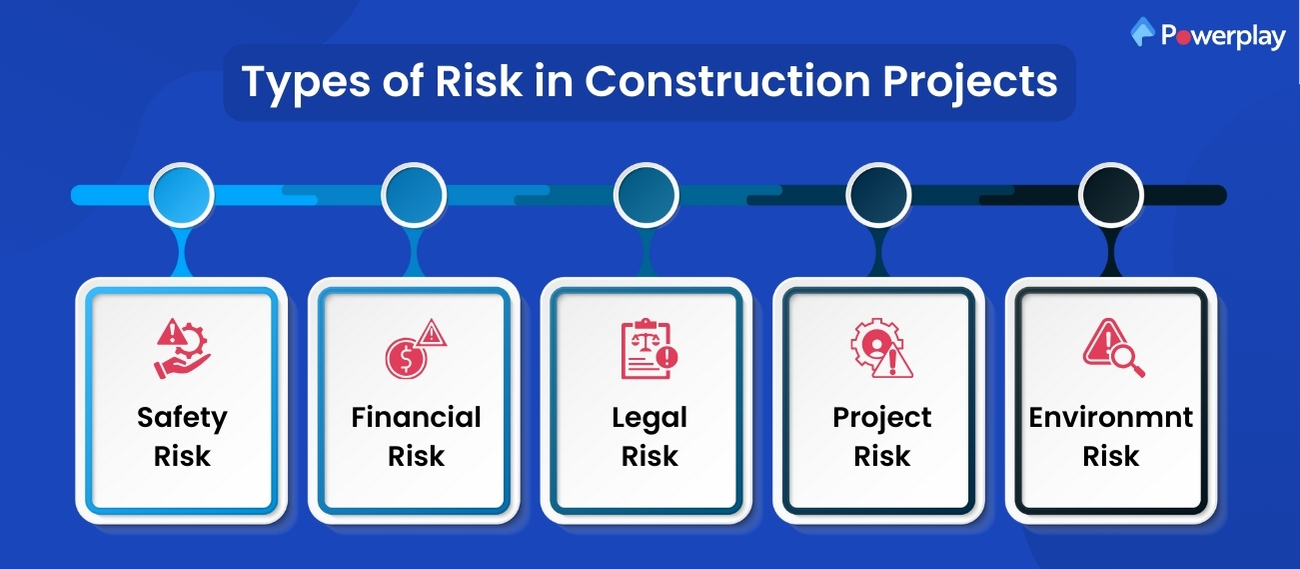
The types of risk in construction projects can be broadly categorised into several areas, such as:
Safety Risk
Safety risks involve any conditions or actions that lead to accidents or injuries on the construction site. This includes risks from unsafe working conditions, improper use of equipment, and hazards related to heavy machinery and working at heights. Managing safety risks is crucial to protecting workers and preventing incidents that could delay the project and increase costs.
Financial Risk:
Financial risks pertain to the potential for financial losses during a construction project. These can arise from factors such as budget overruns, fluctuations in material costs, or inadequate financial management. Financial risks also include the potential for not receiving payments on time, which can affect the project’s cash flow and overall financial stability.
Legal Risk:
Legal risks encompass potential legal issues arising from non-compliance with laws, regulations, or contractual obligations. This can include disputes over contracts, issues related to permits and approvals, or claims of damage or injury linked to the construction work. Legal risks require diligent contract management and adherence to all applicable laws to mitigate potential lawsuits or penalties.
Project Risk:
Project risks are directly related to the execution and management of the project. They include risks such as project delays, technical failures, or inadequate project management practices. These risks can impact the project timeline, the quality of work, or the ability to meet project specifications. Effective project management and communication among all stakeholders are essential for mitigating project risks.
Environmental Risk:
Environmental risks refer to potential negative environmental impacts resulting from construction activities. These can include pollution, waste management problems, disruption of local ecosystems, and non-compliance with environmental regulations. Managing environmental risks involves careful planning and adherence to environmental protection standards to minimise the ecological footprint of the construction project.
The Construction Risk Management Process
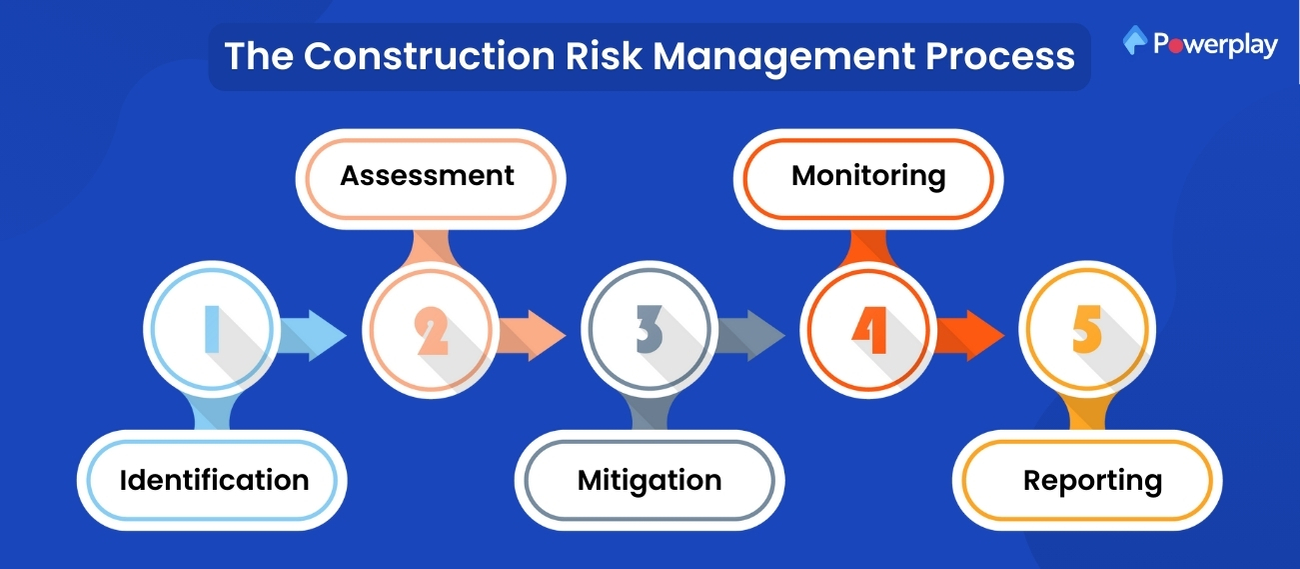
The construction risk management process is a structured approach to managing risks throughout the lifecycle of a construction project. It includes the following steps:
Identification:
Its a first step in risk management process, where potential risks are detected and documented. It involves recognising all the possible risks that could affect the project, including safety, financial, legal, project, and environmental risks. The identification process can involve brainstorming sessions, expert consultations, and reviewing historical data from similar projects. The aims is to create a comprehensive list of risks that could impact the project’s objectives.
Assessment:
Once risks are found, the next step is to assess their potential impact and likelihood. This involves analysing each risk to determine how likely it is to occur and the consequences if it does. Risks are often prioritised based on their severity and probability, allowing project managers to focus on the most critical risks. Tools like risk matrices or scoring systems can be used to quantify and compare risks.
Mitigation:
After assessing the risks, the focus is on developing strategies to reduce their impact. Mitigation involves selecting and implementing actions to either decrease the chances of the risk occurring or lessen its consequences if it does occur. This could include adopting safer construction practices, securing financial guarantees, negotiating clear contract terms, implementing robust project management practices, and taking environmental protection measures.
Monitoring:
Continuous monitoring is essential to ensure that risk mitigation strategies are effectively implemented and to detect any new risks that arise during the project. This step involves regular reviews of the project’s progress and the status of identified risks. Monitoring the risks will help to identify any variations from the plan early on and allow for timely adjustments to risk management strategies.
Reporting:
Effective communication is a key aspect of risk management. Reporting involves documenting and communicating the status of risks and the effectiveness of mitigation measures to all stakeholders. Regular risk reports help keep everyone informed and ensure that necessary adjustments to risk management strategies are made promptly. Reports typically include information about identified risks, their current status, actions taken, and any changes in the risk landscape.
Risk Matrix Template
A risk matrix template is a critical tool in construction risk management. It helps to evaluate the potential impact and likelihood of risks, guiding project managers in prioritising and mitigating them effectively. This matrix aids in visualising which risks could have the most significant impact on your project and planning accordingly.
How To Manage Risks
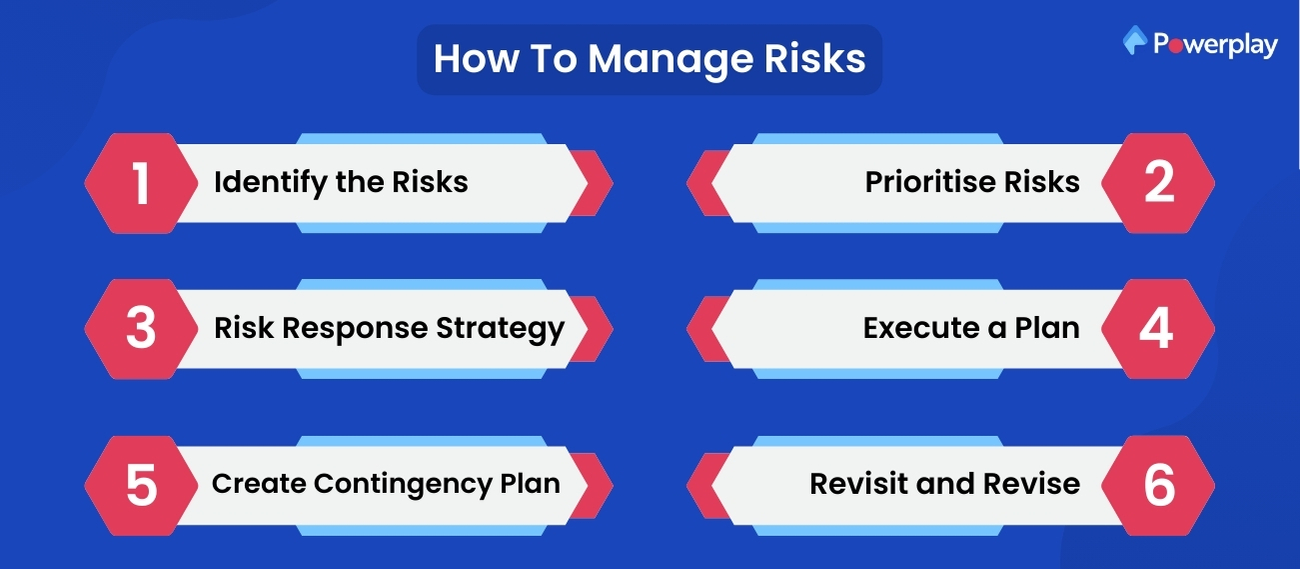
To effectively manage risks in construction projects, it’s essential to follow a structured approach which includes various steps such as:
Identify the Risks:
Start by identifying all potential risks that can impact your project. This includes everything from safety hazards to financial uncertainties. Use project documents, site visits, and stakeholder consultations to uncover internal and external risks affecting project success.
Prioritise Risks in Order of Importance:
After identifying risks, assess their likelihood and potential impact. This will help to prioritise risks based on their significance to the project. High-impact, high-probability risks should be addressed first, while lower risks can be managed later. Tools like risk assessment matrices can be particularly useful in visualising and categorising these risks.
Determine Your Risk Response Strategy:
Choose an appropriate strategy for each identified risk. The main strategies include avoiding the risk, transferring it (e.g., through insurance), mitigating it (by reducing its likelihood or impact), or accepting it when necessary. Each response should be tailored to the nature of the risk and the project context.
Execute a Risk Management Plan:
Implement your risk management plan by detailing the actions and resources needed for each risk. This plan should guide team members in handling risks and provide solutions for mitigation, transfer, or acceptance. Leveraging technology like construction management software can enhance your ability to manage these risks effectively.
Create Contingency Plans:
For risks you decide to accept, develop contingency plans to ensure the project can proceed despite these risks. This might include safety protocols, backup suppliers, or alternative project paths to circumvent potential issues.
Revisit and Revise:
Continuously monitor and adjust your plan of risk management. New risks may emerge, and existing risks might change, requiring updates to strategies and plans. Regular reviews and updates will enhance your project’s resilience against unforeseen challenges.
Who Is Involved in Construction Risk Management?
Construction risk management is a collaborative endeavour involving the entire organisation, with crucial updates on risks communicated across all levels. The primary stakeholders in this process are the project owner team, the design team, and the contractor teams. Each of these groups operates under its own unique set of practices and procedures, making it essential to examine their processes to identify and mitigate risks effectively.
To manage risks efficiently, it’s necessary to gather and analyse a range of information from these teams. This includes cash flow details, drawings and diagrams, project schedules, cost information, inspection reports, project files and logs, contracts, and regulatory documents. By synthesising this information, teams can proactively address potential issues and ensure smoother project execution.
Benefits of Risk Management in Construction

Streamline Operations
Effective risk management helps identify potential issues early, allowing for smoother operations and reduced likelihood of unexpected disruptions. It enables teams to prioritise and address risks in a timely manner, which leads to more efficient project execution.
Enhance Safety
Prioritising risk management significantly increases workers’ safety and well-being. It helps prevent accidents by identifying safety hazards and implementing mitigation measures. This proactive approach not only protects workers but also helps avoid the costs associated with workplace accidents.
Boost Confidence
When risks are managed effectively, it instils confidence among stakeholders, including clients, investors, and team members. Knowing that potential risks are being monitored and addressed can increase trust and satisfaction.
Increase Profits
By minimising disruptions, reducing the chances of costly accidents, and improving operational efficiency, risk management contributes to better cost control and potentially higher profit margins. It allows for more accurate budgeting and less reliance on contingency funds.
Why it’s Important to Manage Construction Risk
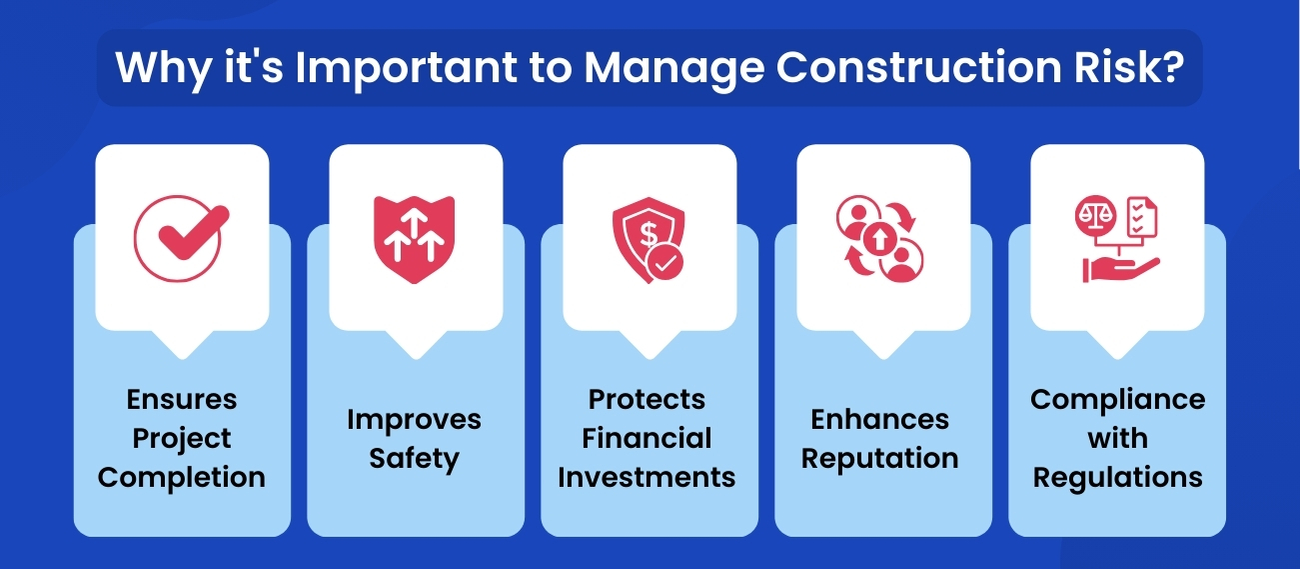
Managing construction risk is crucial for the successful completion of projects such as:
- Ensures Project Completion: Effective risk management helps to find and address potential issues early, preventing delays and ensuring that the project is completion is on time and within budget.
- Improves Safety: By identifying and mitigating safety risks, construction risk management enhances the safety of workers and the public, while reducing the likelihood of accidents and injuries.
- Protects Financial Investments: Managing risks helps to prevent cost overruns and financial losses, safeguarding the investment made in the construction project.
- Enhances Reputation: Successfully managing risks and completing projects as planned boosts the reputation of the construction company, leading to more business opportunities.
- Compliance with Regulations: Proper risk management ensures compliance with legal and regulatory conditions, avoiding fines and legal issues that can arise from non-compliance
What You Should Avoid
Throughout the lifecycle of a construction project, it is crucial to be vigilant about identifying and addressing risks as they emerge. An essential area to monitor is the design phase, where errors or omissions can lead to significant issues during project execution.
External risks also pose challenges, particularly when new stakeholders introduce change requests that can disrupt your well-laid plans. Changes in laws and local standards after the project starts, along with potential gaps in environmental assessments, are additional factors that require proactive management.
Attention must also be given to your workforce. Employing experienced professionals and providing them with safety training is key to minimising risks associated with an inexperienced workforce. Poor morale among staff can lead to high turnover rates or internal conflicts, further jeopardising project success. Ensuring that all permits are current and that construction documents are consistent and clear is another critical step in maintaining an effective construction risk management plan. These considerations, among others, are integral to successfully navigating the complexities of construction risk management.
How Powerplay can help in Construction Risk Management?
Powerplay is the latest construction management software designed to tackle all construction project management-related problems. Risk management in construction has always been a major problem. Powerplay offers various features to tackle this issue and help the owners manage construction projects more effectively and efficiently.

Powerplay features that can significantly aid in managing construction risks:
Project Analytics: Powerplay’s project analytics give you a comprehensive view of the entire project lifecycle. This feature enables you to track progress, detect potential bottlenecks, and assess the overall performance against planned objectives. By analysing key metrics and trends, you can anticipate problems before they escalate, allowing timely interventions to keep the project on track and within budget.
Material Analytics: This feature provides detailed insights into the use and procurement of materials, enabling project managers to identify discrepancies or inefficiencies in material consumption. By closely monitoring material usage, you can prevent shortages, reduce wastage, and avoid delays that arise from the unavailability of essential resources.
Subcontractor Payment Issues: Managing subcontractor payments is a critical aspect of risk management in construction. Powerplay’s platform streamlines the process of tracking and settling payments, reducing the risk of disputes and delays. By ensuring transparency and timely payments, you maintain strong relationships with your subcontractors, which is vital for the smooth execution of any project.
Expense Management: Effective control over project expenses is crucial for avoiding financial risks. Powerplay’s expense management feature helps you track all project-related expenditures, from labour costs to equipment rentals. This lets you maintain a clear view of your financial status, identify areas where costs exceed projections, and make necessary adjustments.
Collaborative Tools: The software includes messaging and document-sharing features that enhance communication among team members. This ensures everyone is updated on risk-related issues and can contribute to risk management efforts.
Conclusion
Effective construction risk management is essential for ensuring project success, enhancing safety, and protecting financial investments. By identifying, assessing, and mitigating risks throughout the project lifecycle, you can streamline operations, boost stakeholder confidence, and increase profits.
Powerplay, with its comprehensive suite of features, supports this endeavour by offering tools for managing risks efficiently. So download the Powerplay app now for a smooth risk assessment and effective management of all your construction projects.













